7 rare Magic cards you've probably never heard of
A handful of strange, forgotten Magic cards, with special commentary from a Wizards legend.
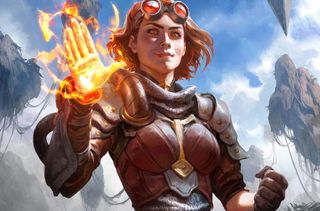
Under boxes of Christmas ornaments or trapped deep in the plastic of ancient Trapper Keepers you might find some of the rarest Magic: the Gathering cards. Over its years as the reigning king of collectible cardstock, Magic has always generated tales of the garage sale Black Lotus, the attic Mox Pearl, and the older brother's forgotten Ancestral Recall.
But in the shadow of Magic’s nine most powerful cards is a murky realm of the unusual, the unobtainable, and the unknown. Let’s bring to light a few of the most interesting with some insight from Mark Rosewater, Magic’s head designer since 2003, Wizards of the Coast employee since 1995, and world-renowned artist.
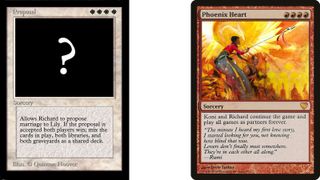
1. The Garfield Event Cards
Value: $5,000 - $15,000 or more
No. printed: Varies, between nine and 220 depending on the card.
Being the father of Magic comes with its benefits, and Richard Garfield has harnessed them to create a few special cards over the years. Starting with the first card, Proposal, in 1993, Garfield had a few copies made with special art he commissioned from Quinton Hoover. In one of the nerdiest proposals ever, he slipped a single copy into his deck, and then didn’t draw it until the fourth game to be able to propose to then-girlfriend Lily Wu.
PC Gamer: Over the years a number of cards have been made for Richard Garfield’s life events, with the most recent known being Phoenix Heart in 2014. What does it say about Magic that these kinds of promotional, arguably indulgent-and-fun cards can be so memorable to some fans?
Mark Rosewater, head designer: Having designed thousands and thousands of cards over the years, I’ve come to see the Magic card as a canvas capable of creating all sorts of artistic expressions. Yes, they can be game pieces, but they can be much more than that. Richard, for example, used it as a means of celebration to publicly acknowledge events that were important to him. I think this struck a chord with the Magic community because it reminds all of us that the game is more than just an activity we participate in, but a means by which we can create a larger community that adds to the richness of our lives.
Has anyone else done something similar?
The biggest gaming news, reviews and hardware deals
Keep up to date with the most important stories and the best deals, as picked by the PC Gamer team.
When my twins were born, I announced it online with a card that I’d made. I didn’t print it like Richard did, but I did share my news with the audience through the medium of a Magic card. (It was the world’s first and only split creature card.) I have likewise heard a lot of stories from fans about how they, or sometimes their friends or family, made their announcements in the form of a Magic card. There seems to be something universal in sharing news through the format of something you love.
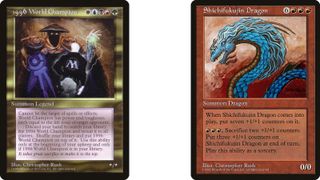
2. 1996 World Champion Card
Value: $17,500 (sold in 2001 to private collector)
No. printed: 1 (rest of the sheet and printing plates destroyed afterwards)
Back in the early days of Magic’s tournament scene, just after the birth of its Pro Tour (now the Players Tour), the third World Championship was to be held at the Wizards of the Coast headquarters in Seattle in the summer of '96. Out of a field of 125 players, relatively unknown Australian Tom Chanpheng took down the heavily favored Mark Justice to win, earning himself a trophy with a one-of-a-kind card embedded in it.
With the 1996 World Championships, we got a corresponding 1996 World Champion card. But never again. Were there ever any plans to continue this trend in the following years?
I never knew of any plans to make another one and I was the person who designed the 1996 World Champion card. I believe it was just done as a one-of promotional event for that specific tournament. I did design one other unique only-one-exists-in-the-world card for a Japanese tournament center. The card was called the Shichifukujin Dragon.
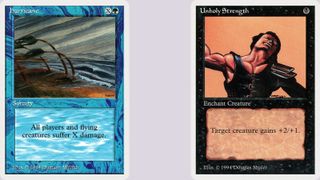
3. Summer Magic (Summer Magic Hurricane)
Value: $10,000
No. printed: Unknown, most product was recalled and destroyed
Riding high on the smash sales success of the game in '93, Magic had ordered another printing of its core set of cards, called Revised. But Revised had some problems, including an incorrect picture for Serendib Efreet, washed out colors, and it even sparked protests over satanic imagery. In an attempt to fix these issues, a new print run was started in the Summer of '94. Despite the intended function of the print run, it came back with a fresh set of mistakes, extra dark inks. The most famous of these was the green card Hurricane printed as a blue card.
There’s always a tension between making things accessible, making things exciting to collect, balancing them for play, and creating fun.
Mark Rosewater
With the printing issues that surrounded Summer Magic in 1994, a lot of product got recalled to be destroyed, and although some clearly made it out there. Legend says that some was given out to Wizards employees. Are there still boxes of Summer Magic floating around?
This is before my time, but the story as I’ve heard it was the cards were printed at our printer in Europe, so no cards, to my knowledge (although again, before my time), were ever specifically in the Wizards of the Coast Renton office or handed out to employees. I do know of a fellow employee who collected a full set of Summer Magic, but he did that on his own and didn’t acquire them through work.
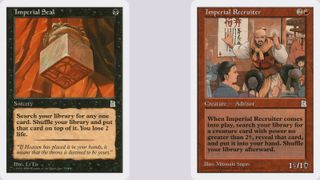
4. Portal Three Kingdoms (Imperial Seal)
Value: $1100
No. printed: Small print run.
The Portal sets were all designed as introductory sets, with the rules of Magic simplified to ease new players in. This trend continued with Portal Three Kingdoms, which was created for the Asian market as a retelling of the Three Kingdoms period of Chinese history. These facts made the size of the print run small, and only a marginal amount of English language booster packs made it to Australia and New Zealand. Years later, in 2005, Portal cards were made tournament legal in both Vintage and Legacy, and a few cards like Imperial Seal became extremely expensive and sought-after components of top decks, with Imperial Seal acting as extra copies of Vampiric Tutor.
With cards like Imperial Seal and Imperial Recruiter in Portal: Three Kingdoms not being tournament-legal at first, was it a surprise to see them become rare, valuable cards?
They were designed as introductory products for beginners to learn Magic, so we had no plans for them to be tournament legal. We did playtest them, but not with the same kind of rigor we do for a tournament-legal product. At the time we made them, we thought some Magic players might want them from a novelty standpoint, but didn’t foresee how sought-after they would become, again because we never thought they’d have tournament relevance.
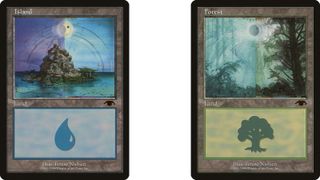
5. The “Guru” Lands
Value: $450—$650
No. printed: Limited promo
Mid 1999 saw a new promotional program aimed at recruiting players to become “Gurus” that would teach new players how to play. Alongside the exceptionally goofy marketing the program provided paperwork and intro decks, and earned each Guru points that would get you basic lands with unique art. With how short of a time the program existed and the rarity of the unique art, this set of five cards would become desirable status symbols for everything from collectors to tournament players.
The Guru program, with its system of Guru points, seemed like it was set up for larger things but never quite got there. Was there ever the intent to introduce more rewards or promotional cards for the program before it folded in 2001? What made the program fold in the end?
I believe the Guru program was created first and then when the team was looking for incentives to encourage people to join they went to a popular well, making Magic cards with unique art. I don’t know if there were any plans to do follow-up cards. I personally never heard of any such plans, but it wasn’t something I worked directly on. I don’t know specifically why the program stopped, but experience from working at Wizards for 25 years is that it wasn’t accomplishing its goals.
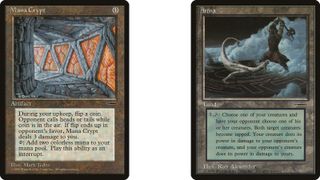
6. HarperPrism Book Promotional Cards (Mana Crypt)
Value: $320
No. printed: Limited promo
With Magic’s success came the beginning of a new series of novels exploring the story behind the setting for the game. Before they were published, a promotional tie-in was dreamed up, and five unique cards were created. Inside the back of each novel was a mail-in form that could net you the appropriate card for the book. Most of the cards were pretty bad, but one of them—Mana Crypt—would be recognized for its power. It was extremely hard to acquire for the next 20 years, only being reprinted in an accessible format with the release of the Eternal Masters set in 2016.
Mana Crypt was a very sought-after card for a long time. It’s since been reprinted in sets like Eternal Masters and Double Masters, has Wizards learned from how popular the card became as a promo-only card?
Magic is both a game and a collectible, so there’s always a tension between making things accessible, making things exciting to collect, balancing them for play, and creating fun experiences. We have learned though that if the newer version is distinct from the original, even in a subtle way, that the collectors can still get excited with collecting the original version while the gamers can have fun, enjoyable experiences with any version. I should note that those aren’t distinct groups. There’s a big overlap in the Venn Diagram of Magic players who love both playing and collecting the game.
When we went back to Magic’s original world with Dominaria in 2018, was there any talk about the old HarperPrism books? Some of us still want to see Garth One-Eye again, especially as a planeswalker card!
We didn’t talk about more books, but you are in luck in regards to Garth One-Eye. While not a planeswalker card, Modern Horizons 2 did print Garth One-Eye as a legendary creature. He even has a cool ability which lets you cast copies of certain cards from back in Alpha.
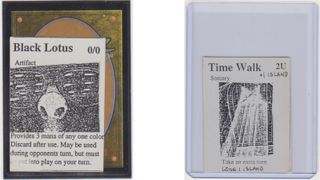
7. Alpha - Beta - Gamma Playtest Cards
Value: $1000 for least desirable commons, far more for the best
No. printed: A few hundred of commons, far less for uncommons, 5-6 of rares at most
When Magic was first being designed, before print runs, cards were hand written (Alpha test), typed or hand drawn with colored circles for mana costs (Beta test), or had low quality black and white printed faces (Gamma test). This process left behind stacks of unusual and interesting relics of the design process on faded paper, and some of the most dedicated collectors of Magic oddities prize them for their novelty and history in the annals of the spellslinging arts.
How have playtest cards changed over the years? Originally we saw handwritten ones with crude photocopy art, but what is that process like now? Do those playtest card mockups stick around, or get thrown out now? I assume there are probably no Alpha or Beta test cards in drawers anymore.
When Richard made Alpha playtest cards they were just printed on paper, photocopied and cut out. Early playtest cards were similar although closer in shape to a Magic card (the Alpha playtest cards were tiny). We then started using stickers that we stuck onto Magic cards. We kept improving the sticker technology, but used them for many years. The latest technology is printing playtest cards directly onto blank Magic cards. Usually, when we’re done using playtest cards, we destroy them, but some are kept as mementos to later share with the public.
Thanks to:
- #MTGRarities: Major Misprints, Test Prints, Oddities Facebook Group
- Keith Adams “The Misprint Guy”
- The Magic Librarities

Sarah is a contributor for PC Gamer, formerly of TechRadar Gaming. With five years of experience writing freelance for several publications, she's covered every genre imaginable and probably a few she made up. She has a passion for diversity and the way different genres can be sandboxes for creativity and emergent storytelling, and loves worldbuilding. With thousands of hours in League of Legends, Overwatch, Minecraft, and countless survival, strategy, roguelike, and RPG entries, she still finds time for offline hobbies like tabletop RPGs, wargaming, miniatures painting, and hockey.

If you love big trucks, establishing trade routes, and the phrase 'post-apocalyptic survival business simulator' then I've got just the strategy RPG for you

Blizzard veteran David Kim's strategy comeback with Battle Aces is 'very personal:' 'I just can't accept... the end-all peak of RTS is StarCraft 2 and nothing can ever be better'
Most Popular


